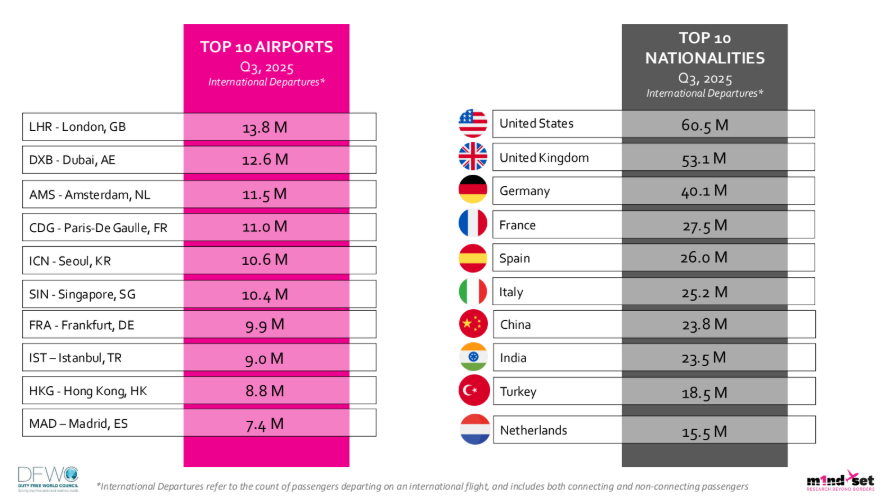November 10, 2025
Middle East & Africa demonstrate robust recovery in DFWC Q3 KPI Monitor
The monitor reveals strong recovery across international air traffic and global travel retail, with passenger volumes surging past 2019 benchmarks

Global air travel has surged past pre-pandemic benchmarks, confirming a sustained appetite for international travel, according to the latest Duty Free World Council KPI Monitor.
The Monitor, which is produced exclusively for the Council by leading travel and travel retail research agency m1nd-set shows that in Q3 2025, international passenger departures soared to 634 million, eclipsing 2019 volumes by 12%.
Based on international traffic data provided by IATA exclusively to m1nd-set through B1S, the DFWC KPI Monitor reveals that the Middle East and Africa region reports the most robust growth at 122% above the same period in 2019 and 74 million international departures (including both connecting and non-connecting passengers).
Growth is broadly consistent across most regions, the monitor reveals: North America (121%), South America (118%) and Europe (113%) posted similarly impressive results, while Asia Pacific (102%) has now surpassed its pre-Covid volumes.

The rankings for the top ten international airports, which remain the same as the previous quarter albeit with a slight reshuffle in the order, underline the strategic importance of major European and Middle Eastern hubs, balanced by strong performance among Asia Pacific hubs. London Heathrow (LHR) cemented its lead in the global rankings among airports with 13.8 million international departures, closely trailed by Dubai (DXB – 12.6 million), with Amsterdam (AMS – 11.5 million), Paris Charles de Gaulle (CDG – 11.0 million), and Seoul Incheon (ICN – 10.6 million) completing the top 5. Singapore Changi (SIN – 10.4 million) follows closely in 6th position with Frankfurt (FRA – 9.9 million), Istanbul (IST – 9.0 million), Hong Kong (HKG – 8.8 million) and Madrid (MAD – 7.4 million) rounding out the top 10.
In terms of the leading nationality rankings for international travel, the DFWC KPI Monitor reveals that the USA (60.5 million) and the UK (53.1 million) lead outbound travel, followed by strong departures from Germany, France, Spain and Italy, underlining the dominance of European demand. China, India, Turkey and the Netherlands complete the top 10 nationality rankings.

Turning to shopper trends, the DFWC KPI Monitor highlights growing tendencies towards more self-indulgence and spontaneous purchasing, as well as positive staff interactions and renewed engagement with digital touchpoints, thanks in part to a growing share of Gen Zs among travelers and shoppers.
Shopper decisions in Duty Free remain fundamentally anchored in value and convenience. “Good value for money” (26% vs 27% in Q2) and “convenience” (22% vs 21% in Q2) stand out as the primary purchase drivers, while items that are “suitable as a self-treat” (19%) continue to gain traction, up from 17% in the previous quarter.

Barriers to purchase among shoppers in Duty Free point to price sensitivity and indifference. Despite improvement on the previous quarter, price perception still acts as a significant barrier. 16% of potential buyers are deterred by factors such as “higher prices vs. home”,(compared to 17% in Q2) and “no motivating discounts” (up from 15% in Q2). Shopper apathy remains a barrier too with 16% claiming they have “no intention to buy” or are “unwilling to carry more items” – also 16%.
The purpose of purchase identified in the Monitor shows a clear and consistent hierarchy, with self-indulgence dominating – up 3% to 56%, followed by gifting (23% vs 24% in Q2), sharing (16% - no move) and on request (5% down from 7% in Q2). Planning behavior among global shoppers denotes a modest shift toward more decisive and more spontaneous purchases compared to the previous quarter. Impulse purchases rose from 29% to 31% between Q2 and Q3 while specific planning rose one point to 29%. The share of undecided planners fell three points to 40% across the period.
The Q3 Monitor also identifies a growing influence of digital touchpoints among shoppers with pre-trip digital engagement on the rise. The share of shoppers exposed to pre-shopping information was up from 31% to 33%, primarily through internet searches (18% vs 16% in Q2), social media (15% vs 12% in Q2), and shopping sites (12% up from 10%). 11% of shoppers also searched for information on retailers’ websites, consistent with the previous quarter, while 11% also searched on travel apps, up from 9% in Q2.
Sales staff interactions remain highly influential in driving conversion. Over half (54%) of shoppers engaged with staff during their last visit, consistent with the share in Q2, and of those 75% reported that the interaction positively influenced their purchase, up 2% on Q2.

Sarah Branquinho, DFWC President welcomed the growing engagement. “The data confirms that digital and social platforms are increasingly shaping travel retail decisions before travelers arrive at the airport, confirming the growing influence of online channels,” she said. “This provides stakeholders with a clear opportunity to engage with shoppers well in advance through these media and platforms to increase footfall and conversion.
“It is also encouraging to see the enduring power of in-store interaction. The data underlines the powerful role of personal engagement and well-trained retail staff. Success in travel retail lies in mastering the blend of enhanced digital pre-engagement with a personalized, high-quality in-store experience.”
m1nd-set CEO and owner Dr. Peter Mohn, added, “The Q3 KPI Monitor reveals a significant psychological shift: the consumer in travel retail is increasingly driven by impulse and emotional reward. This is evident from the notable rise in “self-treat” and spontaneous purchases. While digital outreach is growing, particularly among younger Gen Z shoppers, the final decision still hinges on the physical environment.
“The strategic imperative is clear: travel retail stakeholders need to focus on converting those digital touch point impressions into an engaging in-store experience, which delivers on the shopper’s desire for immediate reward.”




